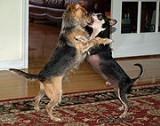
Dog communication
Overview
Animal
Animals are a major group of multicellular, eukaryotic organisms of the kingdom Animalia or Metazoa. Their body plan eventually becomes fixed as they develop, although some undergo a process of metamorphosis later on in their life. Most animals are motile, meaning they can move spontaneously and...
s (usually human
Human
Humans are the only living species in the Homo genus...
s). Dog communication comes in a variety of forms, and is part of the foundation of dog social behavior
Dog behavior
Dog behavior refers to the collection of behaviors by the domestic dog, Canis lupus familiaris, and is believed to be influenced by genetic, social, situational and environmental causes. The domestic dog is a subspecies of the grey wolf, and shares many of its behavioral characteristics...
. Dog
Dog
The domestic dog is a domesticated form of the gray wolf, a member of the Canidae family of the order Carnivora. The term is used for both feral and pet varieties. The dog may have been the first animal to be domesticated, and has been the most widely kept working, hunting, and companion animal in...
s use certain movements of their bodies
Body
With regard to living things, a body is the physical body of an individual. "Body" often is used in connection with appearance, health issues and death...
and body parts and different vocalizations
Animal communication
Animal communication is any behavior on the part of one animal that has an effect on the current or future behaviour of another animal. The study of animal communication, is sometimes called Zoosemiotics has played an important part in the...
to express their emotions. There are a number of basic ways a dog can communicate its feelings. These are movements of the ear
Ear
The ear is the organ that detects sound. It not only receives sound, but also aids in balance and body position. The ear is part of the auditory system....
s, eye
Eye
Eyes are organs that detect light and convert it into electro-chemical impulses in neurons. The simplest photoreceptors in conscious vision connect light to movement...
s, eyebrow
Eyebrow
The eyebrow is an area of thick, delicate hairs above the eye that follows the shape of the lower margin of the brow ridges of some mammals. Their main function is to prevent sweat, water, and other debris from falling down into the eye socket, but they are also important to human communication and...
s, mouth
Mouth
The mouth is the first portion of the alimentary canal that receives food andsaliva. The oral mucosa is the mucous membrane epithelium lining the inside of the mouth....
, nose
Nose
Anatomically, a nose is a protuberance in vertebrates that houses the nostrils, or nares, which admit and expel air for respiration in conjunction with the mouth. Behind the nose are the olfactory mucosa and the sinuses. Behind the nasal cavity, air next passes through the pharynx, shared with the...
, head, tail
Tail
The tail is the section at the rear end of an animal's body; in general, the term refers to a distinct, flexible appendage to the torso. It is the part of the body that corresponds roughly to the sacrum and coccyx in mammals, reptiles, and birds...
, and entire body, as well as bark
Bark (dog)
A bark is a noise most commonly produced by dogs and puppies. Other animals that make this noise include wolves and quolls. Woof is the most common representation in the English language for this sound...
s, growl
Growling
Growling or growl is a low, guttural vocalization produced by predatory animals as a warning to others, as a sign of aggression, or to express anger. Low or dull rumbling noises may also be emitted by human beings when discontent with something or angry...
s, whines and whimpers, and howls.
It is important to note that while many gestures and actions may have common, stereotypical
Stereotype
A stereotype is a popular belief about specific social groups or types of individuals. The concepts of "stereotype" and "prejudice" are often confused with many other different meanings...
meanings, researchers regularly find that animal communication is often more complex and subtle than previously believed, and that the same gesture may have multiple distinct meanings depending on context and other behaviors.

